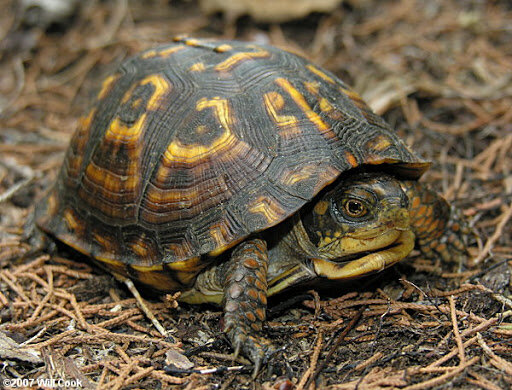With the opening of SciDive, we have sea turtles on the brain! Our staff biologist, Lisa Keys, shared some facts to help explain the differences among sea turtles, turtles and the Science Mill’s African spurred tortoises.
Trick question?
Surprise, they’re ALL turtles! That is, technically speaking. Scientists group species into categories based on shared features. The group Testudines includes species whose bodies are surrounded by shells that are fused with their ribs and vertebrae. “Turtle” refers to all species in that group – including tortoises and sea turtles.
Still, important differences set tortoises, turtles and sea turtles apart. These aren’t hard-and-fast rules, but looking for a combination of these traits will help you start to identify who’s who.
Home, sweet home
Typically, tortoises live entirely on land, while sea turtles live entirely in the water – they only come on land to lay eggs. Turtles spend time in the water and on land. There are, however, exceptions. For example, box turtles spend their lives on land.
Shell shapes
Tortoises have high, dome-shaped shells, while turtles and sea turtles have flatter, more streamlined shells for moving through water. But, again, there are exceptions! The pancake tortoise, as its name suggests, has a flattened shell. It hides out in the narrow crevices between rocks.
A sea turtle’s teardrop-shaped body also makes it easier to glide and dive. It’s awesome for swimming, but has a limitation: sea turtles can’t tuck their heads and limbs into their shells for protection. When a predator is near, sea turtles instead swim sideways to make themselves look bigger – too big to swallow!
Look to the feet
Tortoises have stumpy, flat-bottomed “elephant feet” for walking on land, with strong nails for digging. They tend to move slooooowly. Turtles have webbed toes for paddling through the water and can be surprisingly speedy on land. Sea turtles have fused-together toes that form flippers. They hold the title for fastest-swimming reptiles.
What’s for lunch?
Tortoises love their veggies; as a rule, they eat only plants. Turtles eat a variety of plants and animals, although some species eat only animals – feasting on insects, fish, crustaceans and sometimes even mammals. Most sea turtles eat animals or a mix of plants and animals, such as fish, seaweed and crabs. But a few species have special diets. Adult green sea turtles eat only plants, like seagrass and algae. Hawksbill sea turtles munch mainly on sea sponges. Leatherback sea turtles are “gelatinivores”: they eat only jellyfish, sea squirts and other Jello-like invertebrates.
Speaking of lunch: You can meet the Science Mill’s African spurred tortoises at weekend feedings! Public feedings are scheduled for most Saturdays and Sundays at 2:15pm; check with the front desk or call 844-263-6405 to confirm. For an extra serving of adorable, watch the baby tortoise hatchlings on the live Tortoise Cam.
Explore as a sea turtle!
Now that we know a little more about tortoises, turtles and sea turtles, it’s time for a deeper dive: become a sea turtle with SciDive, our new 4D virtual reality experience! Swim along a digital coral reef and meet a fellow sea turtle, who acts as your guide. SciDive is a not-to-be-missed experience that ages 8 to 108 will enjoy. (Kids must have an arm span of at least 48”, or their parents’ assistance, to ride SciDive.) Limited spots are available for SciDive each day, so be sure to reserve your spot online before you visit.
How can I help turtles, tortoises and sea turtles?
Watch out for turtles and tortoises crossing the road. When roads cut through habitats, they may need to reach a pond or find a safe place to lay eggs on the other side. If you see one crossing and it’s safe to do so, you can even help. Follow the turtle’s lead: don’t turn it in a new direction or move it to a spot you think looks more ideal. That can be disorienting and could put the animal in harm. Instead, help it safely reach the side in the direction it was moving.
Big picture, reducing the amount of plastic we use and finding responsible ways to recycle it also helps – sea turtles often mistake plastic pollution for food or get tangled up. Together, we can help keep our oceans clean and sea turtles safe and healthy.









